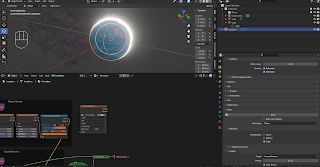Planet Generator Blender File
A significant milestone that is very visible is the Terrain Generator. This takes a Icosahedron in Blender and allows blender to make it a 3d Planet for Render OR to Bake the proceedural terrain on it and import that image into a terrain map.
The World Building Book will provide the File, Templates, and Workflow and Nicco and I will make desktop recordings of us making it for ease of follow.
The target is that it takes 5 minutes to figure it out the first time following the tutorials and <1 minute to set it to "Bake" (Generate the UV map) and a simple motion of getting the file and placing it on the Presentation Template.
Limitations:
- Redering it 2k or 4k (2048x2048 or 4096x4096) varies from computer to computer.
- We will come up with a more Detailed Map later on as we get more sales and feedback. What you see so far is the first versions reminicent of some other Map making software tools.
- We cant make it a simple all in one package.
Other Milestones
- Final Draft of Gravity. The sad thing about the system is that to be realistic it may be unplayable, but the methods will be a section still. Basically since MASS is the main variable getting the gravity from the mass is one of the hardest parts. Its a 5 step process vs just creating a Table of Rolling Gravity Randomly (which still includes a way to calculate the Radius based on the Mass and Gravity).
- EASY PROCESS: roll Rocky (Terrestrial) World from 0.001 Earth mass (Dwarf Worlds like the Luna and Jupiter Moons) to 10.0 Earth mass THEN > Roll gravity. Gravity table is not tied to the World's mass its possible to roll 0.3G for the largest Earth Mass of 10.
- HARD PROCESS. Roll EARTH Mass > Roll Earth Density (Density of the world as compared to earth with earth's density being 1 at 5.5 tons/cubic meter) > Convert to Earth Volume > Convert to Earth Radius > Derive Gravity. This is an optional system that will be there.
- Changes to Main World. So the "Main world" is going to be either a 10 Earth mass world to 0.01 Earth mass World or a Moon/Luna Sized Terrestrial World.
- HABITATS TL8-9 are possible main worlds and we roll the VOLUME in cubic meters (Noted as Volume Tons as 1 cubic meter is 1 volume ton). THis affects the population roll.
- 1st Draft of Positioning. It just needs polishing and proof reading by Nicco. Nicco will also do the layouting. The formula for Positioning: Where planets are positioned based on their Traits. Starting from the MAIN WORLD, then everything else.
- Planetary Systems. I just need to finishing the write up of about a page, Nicco will clean it up for me after. What remains is the detail works of generating the planetary systems. You will notice that I'm kinda particular about the workflow as the GM.
- Outline of INHABITANTS. so the outline of the Inhabitants are done. I have already started to detail it with definitions but as for a clear coherent system I've not yet detailed. Then nicco will polish it.
- The Major Art is done: Solar System Formation and Vortexes.
- The Cover will be Last before publishing.
- I want 2 weeks to proof read and to send it out to a different proof reader I have in mind. I'm lucky to know 2 physics graduates (one former professor and one who is working in media)
- SOL SYSTEM will follow the Creative Common of Beinahegut where we will build on this - the goal is that when people buy it they can start playing in a SOL based adventure - like the Expanse.
- the HEX solar system method. Hex map of Sol and how to make hex maps of other sytems. as mentioned this may follow but we will have SOL to follow after march 31 deadline. We will add earth and other Planetary systems for such games that just focus on 1 planet system.
- Google Spreadsheet tools will follow once the system is complete (Target March 15 onward).
- So I learned a bit of javascript/appscript for this and I'll be teaching Nicco the scripts how create the Google Appscript Sheet that will generate Systems proceedurally with all the details. A place to Cut and Paste the output in a Player Friendly manner.
- The Basic Main World Creation can be done. My main problem is creating the other worlds -which is either additional Columns or Additional Rows - which would mean the MACRO/appscript will begin to population and position other Worlds. As well as how much detail we will have of these worlds.
- Main world means Rolling the Main World + Habitability + Gravity + Position + Primary Star + Star Class and Qualities + Disks + Other Worlds + Inhabitants (in Aggregate) + TL + Development + Power Structure + Power Source + Star Port.
- Not included in the basic Spreadsheet are the Planetary Systems + Qualities and Position.




No comments:
Post a Comment